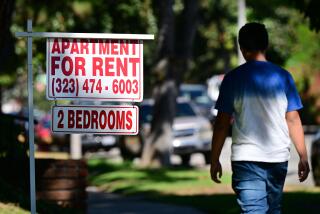L.A. rent rose 65% over the last decade, study shows
On Wednesday, a sweeping rent control bill will take effect in California, capping yearly rent increases at 5% plus inflation and requiring just cause for eviction. But after the last decade for L.A. renters, the new protections appear akin to putting a Band-Aid on a bullet wound, according to a new study from listing service RentCafe.
The report — which synthesized data from PropertyShark, Yardi Matrix and the U.S. Census Bureau — found that the average rent in the city of Los Angeles has ballooned to $2,527, a whopping 65% increase since 2010. That’s significantly higher than the national average rent increase of 36% over the same period.
In Westwood, the average rent is nearly double that. The Westside neighborhood of UCLA students and young professionals has an average rent of $4,944 a month, The Times previously reported. That’s not only the highest rate in L.A. but also in all of California.
Family incomes have been unable to keep pace, the report also found. During the last 10 years, L.A.’s median household income grew 36% to $64,036. That’s slightly more than the national increase of 27% but far shy of the 61% jump San Francisco saw.
The findings arrive as renting continues to rise in popularity, with an increasing number of people renting by choice rather than necessity, according to the RentCafe report.
The 2010s saw the number of U.S. renters surpass 100 million for the first time, growing from 99.4 million in 2010 to 108.5 million in 2018. That means renters make up 34% of the U.S. population, up a full percentage point from a decade ago.
That number is nearly double in L.A., where renters make up 60% of the population. That ranks as the 19th-highest rate among the country’s 260 largest cities. Glendale boasts the state’s highest concentration of renters at 67%.
Over the course of the decade, 2.4 million apartment units were built in the U.S. to meet the rising demand, the study found. Roughly 98,000 of those were constructed in L.A., good for fifth-most in the country. A flurry of notable developments moved forward this year, including a controversial project that’s adding 725 units across five seven-story apartment buildings in Chinatown.
Other developers are taking advantage of a city program that allows for larger-than-usual projects near transit if developers ensure some units are affordable for people with lower incomes. On Venice Boulevard, one such builder is erecting an eight-story building with 79 units on a site zoned for 46 units by reserving eight for low-income households.
With land at a premium, however, apartments are becoming smaller. In 2010, new apartments covered an average of 990 square feet. Now, they average 933 square feet, according to the report. That’s a drop-off of 57 square feet — roughly the size of a small office or storage room.
The national average decrease is about 6%, but in Anaheim, new apartments shrank an average of 12%, which is the eighth-largest drop-off in the country.
The new rent control laws coming in 2020 will last for a decade and look to help out the roughly 9.5 million renters in California who spend more than 30% of their income on housing costs. In response, some landlords have considered more frequent rent increases, while others started handing out no-fault eviction notices to those who were paying low rent before the law forbids it next year, The Times previously reported.
As a result, the Los Angeles City Council was forced to approve an emergency moratorium in October outlawing no-fault evictions. The ban requires just cause to remove tenants, such as not paying rent or destruction of property.







